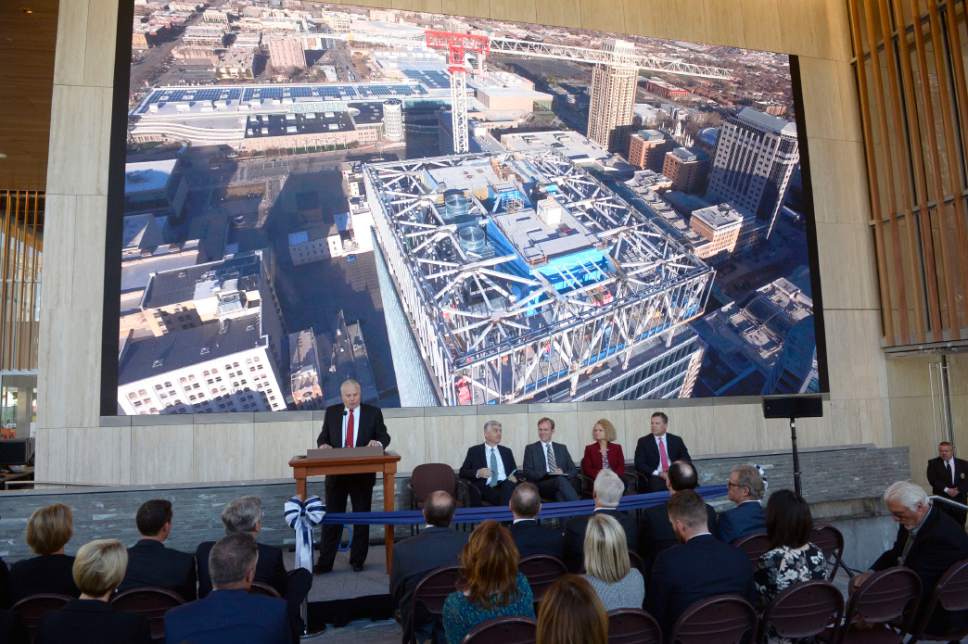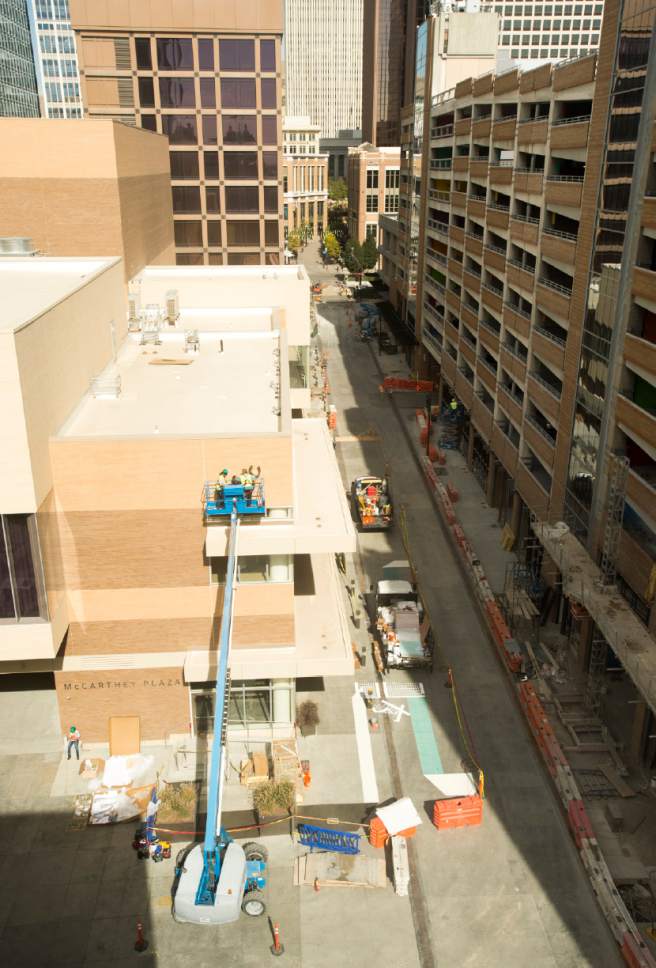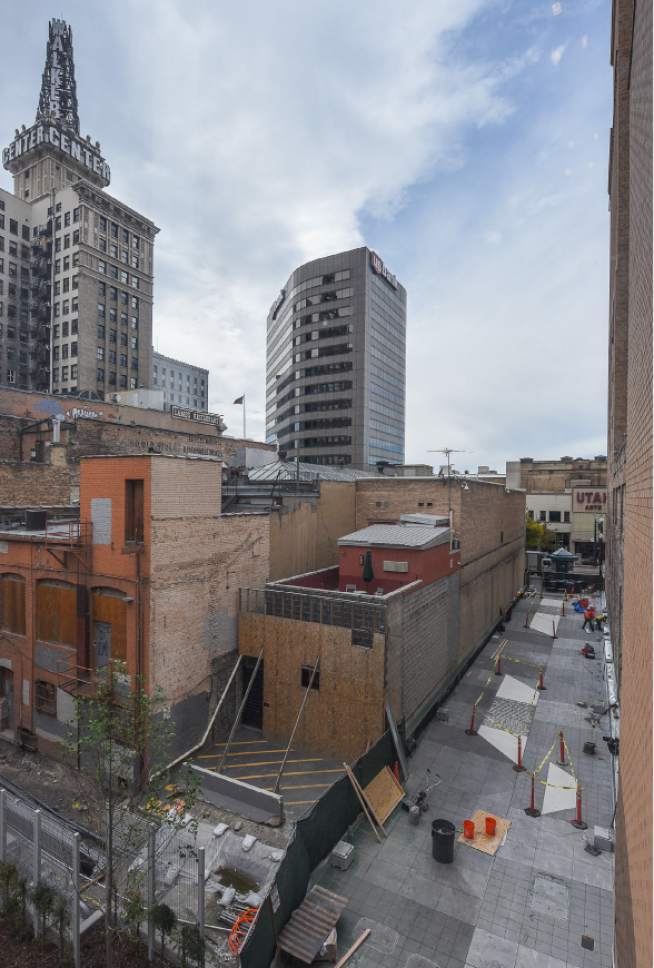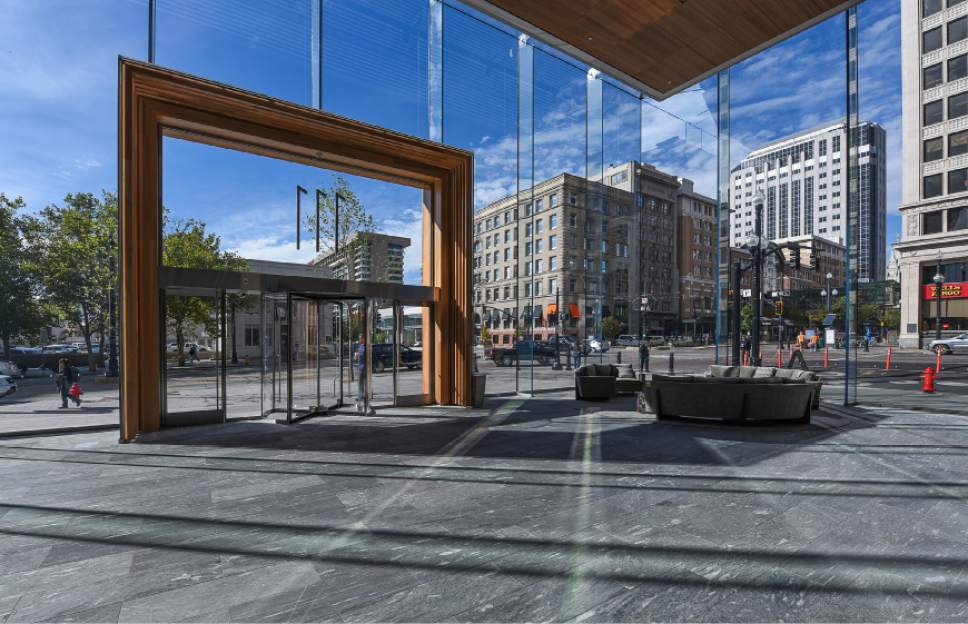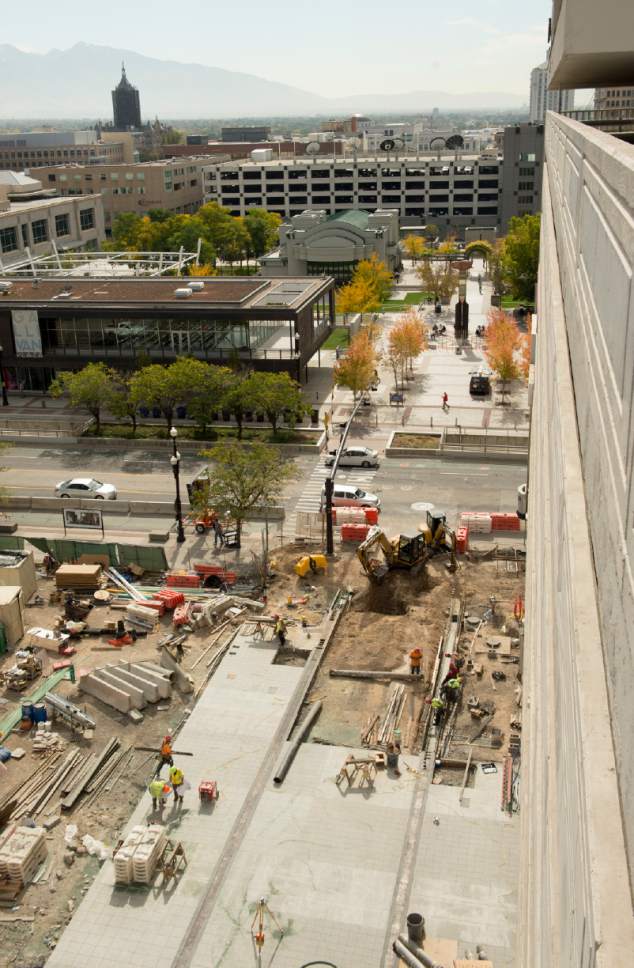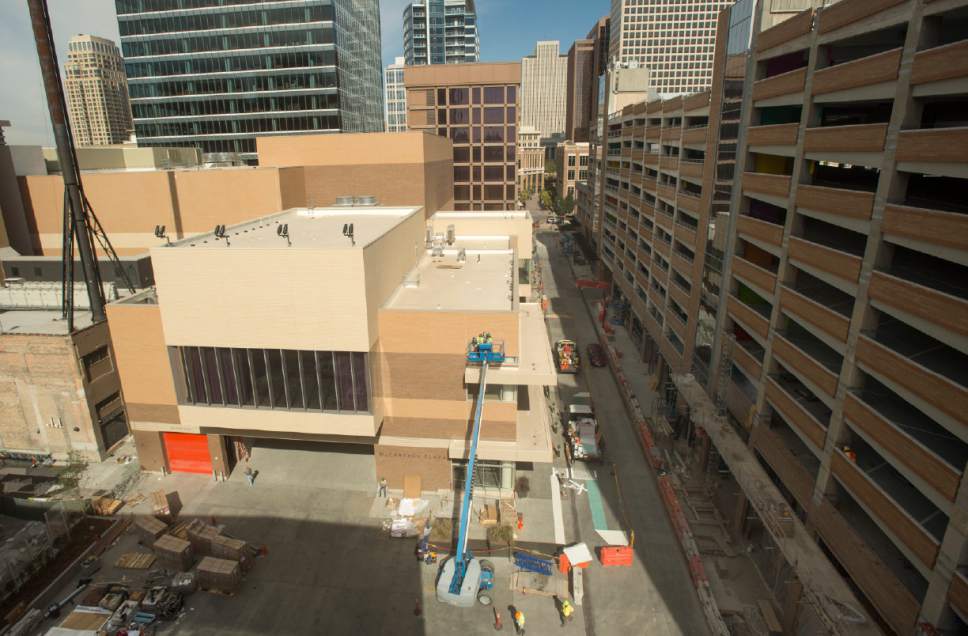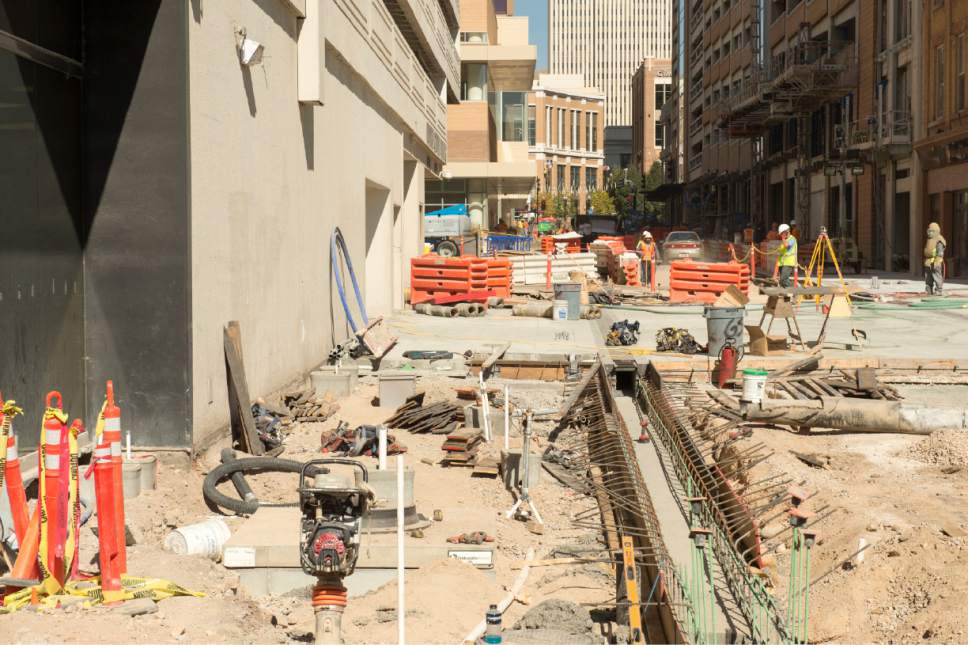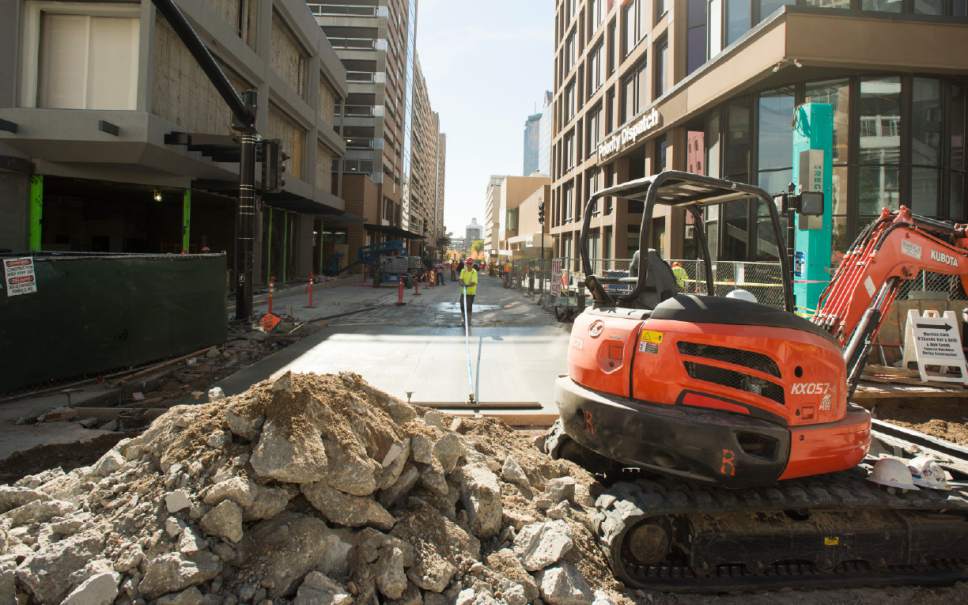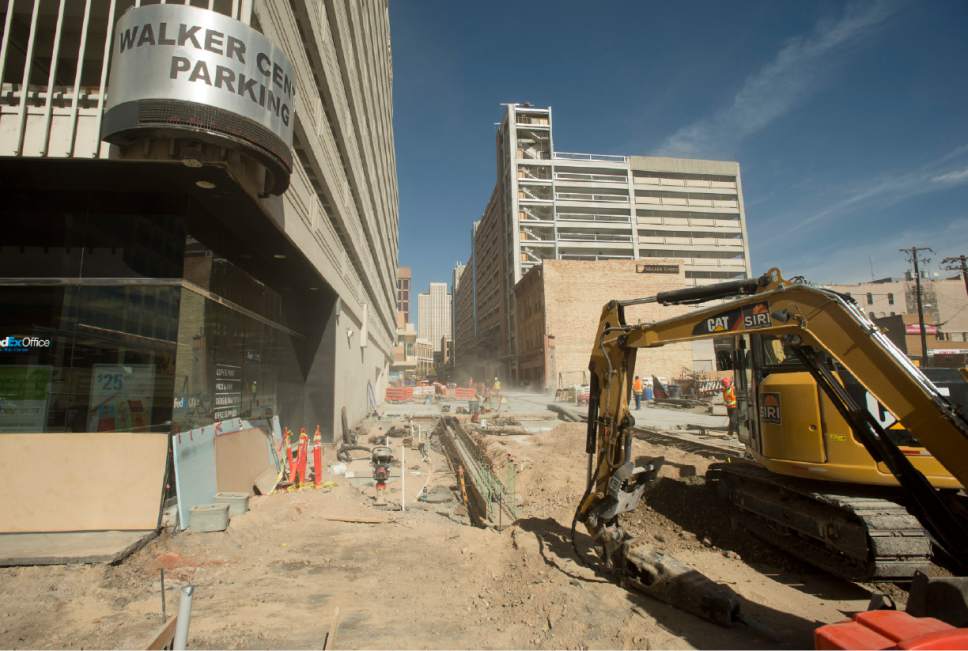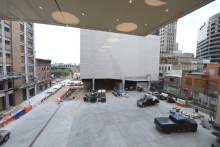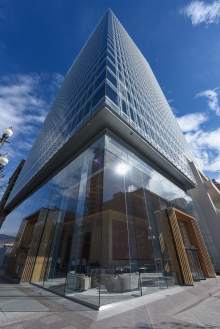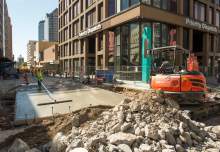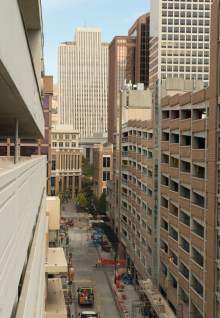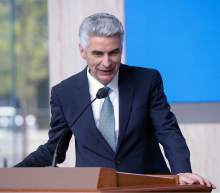This is an archived article that was published on sltrib.com in 2016, and information in the article may be outdated. It is provided only for personal research purposes and may not be reprinted.
Imagining Salt Lake City's second century, leaders predicted two generations ago that a Broadway-style theater would bring new prosperity to downtown.
Thanks to economic factors they could not have foreseen — and plenty of serendipity — anticipated gains to the central business district from the 2,500-seat George S. and Dolores Doré Eccles Theater are likely to be even larger than envisioned.
Expected to draw thousands downtown by itself, the $119 million arts and culture hub at 131 S. Main opens this week with two companion developments: a 24-story office tower to the north and a pedestrian-friendly plaza to the rear.
The nearly simultaneous opening of the Eccles Theater, the 111 Main high-rise and an overhauled Regent Street on what is known as Block 70 is being viewed as a watershed moment. It already is spurring new investment and, officials say, could transform how Salt Lake City markets itself to the world.
On the ground, the additions are projected to bring more than 7,000 visitors downtown at peak times — levels of foot traffic and commercial activity reminiscent of the 2002 Winter Olympics.
The projects are being unveiled amid a multiyear upswing in commercial real estate markets downtown.
Longer term, top-flight and visually appealing amenities on that high-profile block have the potential of adding to downtown's cache in workforce recruitment as employers seek talented new executives and entrepreneurs consider locating in Utah's capital.
"People want to live in places that are cool and dynamic and interesting," said Jason Mathis, executive director of the merchant-backed Downtown Alliance. "It's difficult to overestimate the role the theater will have downtown in our economic and cultural life."
So difficult, in fact, that city officials temper their public talks on how the Eccles Theater and surrounding developments came together, so as not to take too much credit for good luck.
"It happened by accident," said Justin Belliveau, head of the city's Redevelopment Agency (RDA).
—
The 'Main' concern • Built with taxpayer funds and private donations, the theater's main feature — its 2,500-seat Delta Performance Hall — is intended as a regional arts hub, answering calls nestled in city master plans since the mid-1960s.
Eccles Theater is accompanied by a smaller on-site theater, several event and rehearsal spaces, a lobby restaurant, an outdoor plaza and a galleria connecting it to the adjacent office tower.
Under daily operation by Salt Lake County, the facility is expected to host events ranging from full-scale Broadway shows to community gatherings on at least 200 nights a year.
Magnifying its benefits has been a key factor in the theater's location, design and construction. Most strikingly, architects sought to visually connect the theater's six-story lobby, other interior spaces and an upper-level balcony to its surroundings through an exterior of glass walls.
"There had to be some real interaction with Main Street," City Councilman Stan Penfold said.
The council's guiding document for the theater, Penfold recalled, was heavy with words such as "activation," "engagement" and "transparency." Unless the venue was being rented out privately, he said, the lobby would be open to the public.
"What we ended up with," Penfold said, "was that amazing ability for that entire theater to open up onto Main Street."
* * *
High-rise, high quality • Developers with LDS Church-owned City Creek Reserve Inc. (CCRI) have also sought to maximize gains from the theater and its own tower development, which is located just south of City Creek Center, CCRI's $1.5 billion-plus mall.
In early property negotiations for the theater, church officials reportedly were adamant the Eccles project include an office tower. They went to great lengths to achieve it.
The result: an architecturally innovative, 387-foot skyscraper with 439,611 square feet of office space. Constructed to high standards, 111 Main has its own porous feel at ground level, with an airy and accessible lobby wrapped in 35-foot-high glass windows and a massive, eye-catching video wall.
Upper floors in the city's third-tallest building offer excellent views. The structure is topped by a 32-foot-high translucent glass cap capable of sophisticated light shows.
The offices are more than 80 percent leased, anchored by global investment banking firm Goldman Sachs, a CCRI official said in September. The building is expected to bring 4,000 workers downtown daily when fully occupied.
CCRI spokesman Dale Bills said 111 Main "continues City Creek Reserve's commitment to encouraging economic vitality in Utah's capital city."
Bills said the venture also furthered one of CCRI's main objectives for building City Creek Center — "to serve as a catalyst for added investment in the heart of Salt Lake City, especially along the Main Street corridor."
"These two leading-edge structures, combined with the renewal underway on Regent Street," Bill said, "will bring increased vibrancy not only to Block 70 but to the entire central business district for decades to come."
Tucking the 185,000-square-foot theater nearby was anything but easy. In fact, the engineering challenges of dovetailing the two forced an initial tower developer — Illinois-based Hamilton Partners — to hand off the project in 2014 to CCRI, a real estate arm of The Church of Jesus Christ of Latter-day Saints.
CCRI and its architects with Chicago's Skidmore Owings & Merrill and Salt Lake City-based VCBO Architecture deployed a one-of-a-kind hat-truss system to support the building, propping up most of its weight from a concrete core at the center rather than with exterior columns.
While CCRI has not shared its price tag for 111 Main, the hat truss clearly boosted costs. The system was essential to granting a city request for a visually stunning, 47-foot cantilever extending southward from 111 Main over the theater's roof.
"Those were some tense discussions," Belliveau recalled. "But I firmly believe we never would have been able to develop the theater on this block had they not been willing to make that accommodation.
"Every detail of that project was deliberately selected," he said, adding that CCRI's intention "was to make this a timeless building."
Bills said CCRI "enjoyed extraordinary cooperation" with the RDA in constructing Eccles Theater and 111 Main side by side. "The buildings," he said, "share a symbiotic relationship in design, construction and ongoing operation."
In a September opening ceremony for 111 Main, Presiding Bishop Gérald Caussé, who oversees the LDS Church's vast real estate and commercial holdings, spoke in reverent terms of the church's sense of economic stewardship over that downtown corner, just blocks from Temple Square.
"This is sacred ground," Caussé said.
* * *
Word on the street • Behind the theater, another nod to history is underway.
The gritty and rundown midblock segment known as Regent Street and three connecting streets are getting a $12.8 million face-lift from the RDA, with the help of tax revenues generated from 111 Main.
Crews have been gradually transforming the streets into a trio of tree-lined, walkable thoroughfares to be populated with retail shops, restaurants and a public plaza. Work was still underway last week.
The north-south corridor feeds directly into entrances for City Creek Center to the north and Gallivan Center to the south, junctures that already boast some of the city's highest daily pedestrian counts.
Phil Jordan, director of Salt Lake County's Center for the Arts, referred to the new pedestrian connector as "a cultural byway," linking Temple Square and City Creek with Gallivan Center and downtown amenities farther south.
Once home to several Utah newspapers and, before that, Salt Lake City's red-light district, the revamped Regent Street will eventually feature more than $2 million in commissioned art pieces, many of them interactive, to delight diners and theatergoers.
Elements of the streetscape — from sidewalk furniture, tree grates, planters, light poles and bike racks to its trash cans — will have matching designs as a backdrop to rotating street performances and art installations.
"What's being developed on Regent Street is so much more than a midblock connection," said Lara Fritts, Salt Lake City's new economic development director. "It's really a new place in our city — and one that connects with other important places."
And these places may draw crowds well into the city's third century.
Twitter: @TonySemerad


